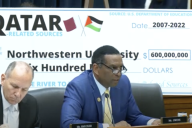You have /5 articles left.
Sign up for a free account or log in.
The University of Virginia’s Black Student Alliance and other student groups representing the campus’s minority populations have drafted 10 demands for the administration there, among them that Confederate symbols should be removed from the grounds and that the institution should enroll more black students.
The list comes following the deadly unrest last month in Charlottesville, Va., that drew white supremacists from across the country to march both on the UVA campus and in the city.
The Black Student Alliance published a statement to Facebook earlier this month after the protests, announcing multiple events to help “heal” the campus.
“We are students of color; we are exhausted. We want to know when the University of Virginia will stop asking us to renew our patience, stop asking us to tolerate intolerance and stop allowing this horrific history of hatred to carry on. When will we have the opportunity to just be students here, unencumbered by an atmosphere of unwelcome?” the statement said.
Groups representing Latino students, queer students, Asian students and the university’s student council all signed on in support of the demands.
University spokesman Anthony P. de Bruyn said that President Teresa Sullivan will meet soon with the authors of the demands to discuss their concerns.
Faculty will need to discuss requests related to curriculum, de Bruyn said. Others may be referred to a working group that Sullivan established to asses how the university handled the protests on campus.
The requests are as follows:
- Remove the Confederate plaques on the rotunda. An appropriate place would be in a museum or in Special Collections.
- Declare the lawn a residential space. Concealed arms and open flames should not be allowed within this space.
- Acknowledge the $1,000 gift to the University’s Centennial Fund received from the KKK in 1921; reinvest this amount, adjusted for inflation, into existing UVA and Charlottesville multicultural organizations; and include this racist history at UVA into education surrounding the [university's] bicentennial [the celebration of which begins next month].
- White supremacist hate groups, particularly UVA alumni Jason Kessler and Richard Spencer, should be explicitly denounced and banned from campus. They have already incited and perpetrated violence against students past the point of free speech.
- All students, regardless of area of study, should have required education (either inside or outside the classroom) on white supremacy, colonization and slavery as they directly relate to Thomas Jefferson, the university and the city of Charlottesville. The current curriculum changes only affect the College of Arts and Sciences and allow students to focus in on aspects of difference of their choice.
- UVA’s historical landscape must be balanced. The statue of Jefferson serves as an emblem of white supremacy and should be recontextualized with a plaque to include that history. Additionally, more buildings named after prominent white supremacists, eugenicists or slaveholders should be renamed after people of marginalized groups.
- Expand the working group on university response to the events of Aug. 11-12, 2017, to represent students of color and those affected by the violence of Aug. 11-12.
- As of last year, the percentage of African-American undergraduate students enrolled in the university was 6.4 percent. The university must take action to ensure that as a public university, this number is reflective of state demographics at a 12 percent proportion. Given the impact of recent events, action on this step is crucial.
- In 2016, the percentage of African-American faculty was 3 percent. This percentage is unacceptable and disproportionate to the number of African-American students. This disparity exists across all minority groups. Thus, proportion of faculty for an underrepresented group should strive to match the proportion of the student population of that group at minimum.
- Issue a strategic and actionable diversity plan, with input sourced from minority student leadership, as done by other peer institutions such as Georgetown University, Brown University and Virginia Tech. This plan should include a special emphasis on improving diversity and inclusion for faculty, staff and students of color, as well as relations with the Charlottesville community.








